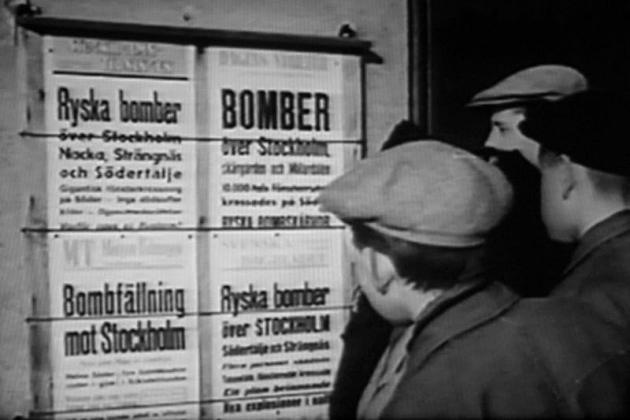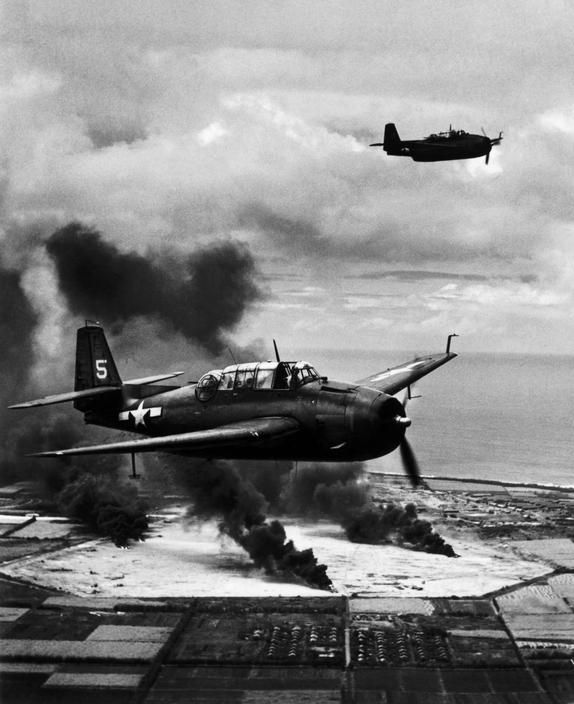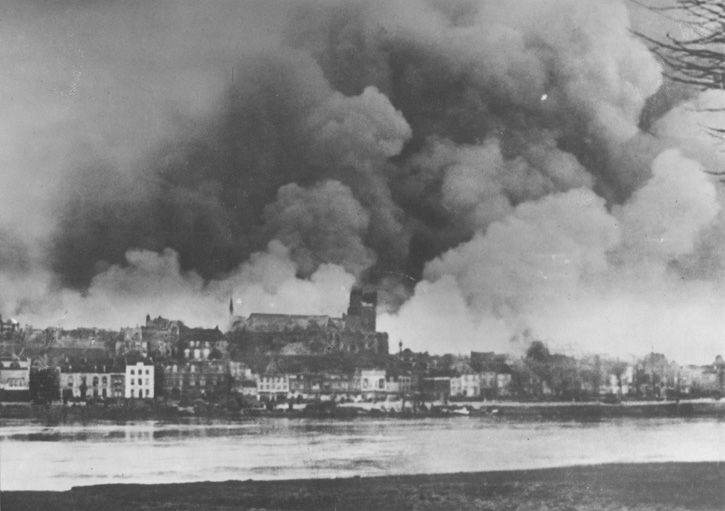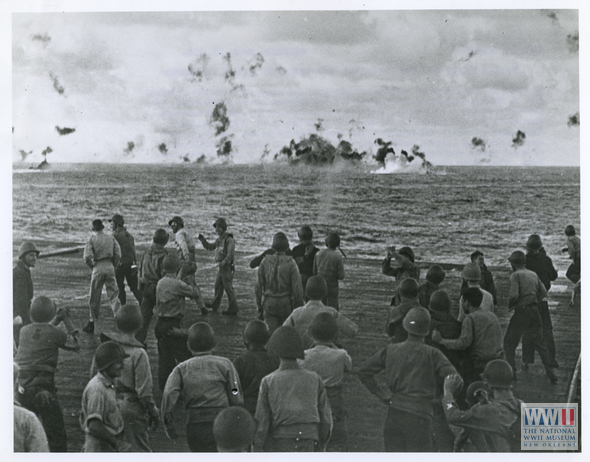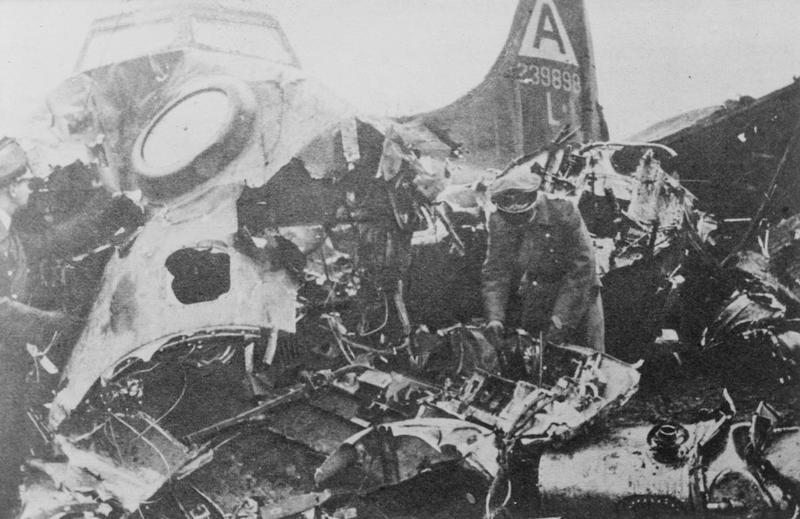Air Operations, Bismarcks
- 70 AirSols TBFs and SBDs attack shipping in Keravia Bay. More than 40 XIII Bomber Command B-24s attack the Lakunai and Keravat airfields at Rabaul.
- US destroyers operating in daylight in the Rabaul and Kavieng areas are not molested, leading Allied intelligence specialists to conclude that all or most Japanese aircraft in the region have been withdrawn.
- More than 60 V Bomber Command B-24s and B-25s attack Japanese Army ground positions at Iboki Plantation on New Britain in support of a US Marine ground advance through the area.
Air Operations, CBI
BURMA- More than 70 10th Air Force B-25s, P-51s, and A-36s attack numerous bridges, supply dumps, and targets of opportunity. 14th Air Force P-40s attack a large riverboat at Bhamo.
- 14th Air Force P-40s attack the airfield at Kengtung.
Air Operations, Europe
- In dense cloud and freezing conditions, a B-24 group bombs Nijmegen, Holland by mistake, killing 200 civilians.
- US 15th Air Force bombers from Italy join in the attacks on German aircraft factories.
Evening Ops:
- 10 Mosquitos are sent to Stuttgart, 8 to Duisburga and 3 to Aachen, 71 Halifaxes and 40 Stirlings are sent to lay mines off the north German coast but are recalled because of bad weather over their bases, there are 2 RCM sorties and 2 Serrate patrols.
- There are no losses.
GERMANY:
- Severe weather conditions over northwestern Europe cause 544 of 799 B-17s and B-24s to be recalled or abort on their own. Just 81 of 289 1st Bomb Division B-17s to attack the briefed primaries, the aircraft-industry factories at Aschersleben and Bernburg while 100 others attack various targets of opportunity. Only 74 of 177 2nd Bomb Division B-24s dispatched drop their bombs on four Dutch towns thinking they are over Germany.
- 38 B-17s and 3 B-24s are lost, 4 B-17s are written off; 35 crewmen are killed, 397 are missing
- Escort and support for the 8th Air Force heavy bombers is provided by 659 USAAF fighters. USAAF fighter pilots down 57 Luftwaffe fighters, 1 Ju-88, and 1 Italian-made flying boat over Germany, Belgium and the Netherlands between 1215 and 1555 hours.
- 8 P-47s and 3 P-51s are lost with their pilots
NETHERLANDS:
- 66 IX Bomber Command B-26s attack the Gilze-Rijen Airdrome, but more than 100 other abort due to bad weather.
ITALY:
- XII Bomber Command B-25s attack a marshalling yard and a rail bridge.
- XII Bomber Command B-26s attack a rail bridge.
- XII Air Support Command A-20s, P-40s, and P-47s attack targets near Campoleone.
- XII Air Support Command A-36s attack gun emplacements and troops near Carroceto.
- XII Air Support Command P-47s attack the road net around Roccasecca.
- Fighter pilots of the 12th Air Forc's 31st and 324th Fighter Groups down 9 Bf-109s and damage or possibly down 8 other Luftwaffe fighters in two separate engagements over central Italy between 0750 and 0910 hours.
GERMANY:
- In the main 15th Air Force attack of the day against aircraft factories in the city of Regensburg, in southern Germany, 118 B-24s demolish a good part of the Obertraubling Messerschmitt fighter assembly plant, but the bomber force is attacked by and estimated 120 Luftwaffe fighters.
- 14 B-24s are lost
- 65 B-17s attack the nearby Prufening Messerschmitt components factory with 153 tons of bombs.
- 5 B-17s are lost
- The marshalling yard at Peterhausen, a secondary target, is struck with 42 tons of bombs by 21 15th Air Force B-17s after they go astray of the main body of heavy bombers bound for Regensburg.
- Penetration and target escort is provided by 122 15th Air Force P-38s, and withdrawal escort is provided by 63 P-47s. Despite ample opportunities to score, no Luftwaffe fighters are downed.
- 1 P-38 and 1 P-47 are lost
- 304th Heavy Bomb Wing B-24s attack port facilities at Sibenik.
- 28 5th Heavy Bomb Wing B-17s attack the airdrome at Zagreb.
Air Operations, Marianas
- Beginning with a dawn sweep mounted by 48 F6Fs, carrier aircraft from Task Group 58.2 attack airfields and shipping at Guam and Saipan islands, and aircraft from Task Group 58.3 attack airfields and ground targets at Tinian and Rota islands. When a previously unknown airfield is located on Guam, it is also attacked.
- 168 Japanese aircraft are claimed destroyed in the air and on the ground. US carrier aircraft also attack Japanese Navy transports, of which several are claimed sunk and the rest are driven into the teeth of waiting US submarines.
- A VF-25 F6F downs a G4M 'Betty' torpedo bomber near Task Force 58 at 0620 hours. F6Fs down 2 Ki-48 'Lily' bombers, 4 G4M 'Betty' bombers, and 16 A6M Zero and Ki-43 'Oscar' fighters over Saipan and Tinian between 0645 and 0800 hours. 5 Zeros are shot down over Guam between 0815 and 0835 hours, 1 Zero over Tinian at 0945 hours and 7 Zeros over Saipan between 1245 and 1300 hours.
- Task Group 58.2 and Task Group 58.3 retire toward Majuro during the afternoon, but they are attacked almost continuously between 2000 hours, February 22, and 0900 hours, February 23, by 4 waves of land-based aircraft. Antiaircraft fire keeps many of the attackers at bay, and skillful maneuvering saves the ships from any damage. Nevertheless, a strong case is made in favor of stationing night fighters aboard all the fast carriers.
Air Operations, Marshalls
- 8 531st Fighter-Bomber Squadron A-24s and 9 15th Fighter Group P-40 fighter-bombers attack the Mille Atoll. During the mission, in the first attack of its kind undertaken by a 7th Air Force warplane, one P-40 fires aerial rockets at a ground target.
- ;Following days of air, naval, and artillery bombardment, US Marine ground troops land on Parry Island, where opposition is spirited and unyielding. However, the island—the last objective in the Marshalls—is declared secure at nightfall. The Eniwetok Atoll is also declared secure.
- Task Group 53.6 is relieved from covering the Eniwetok operations by the USS Manila Bay (VC-7); and the seaplane tender USS Chincoteague arrives to support operations by Task Force 57 amphibian scout bombers, which immediately begin a program of search operations to the west.
Air Operations, New Guinea
After diverting from the Admiralty Islands in the face of bad weather, V Bomber Command B-24s attack targets in the Madang area, and B-25s attack targets around Rein Bay. Also, V Fighter Command P-39s attack targets in the Madang area.
[Britain, Home Front
Churchill makes a statement in the House of Commons about relations between Russian and Poland. He declares that the USSR desires a strong, independent Poland and that, if the eastern frontier of Poland has to be adjusted at the end of the war, territorial compensation will be made at the expense of Germany both in the north and the west. Four days later the Polish government-in-exile in London protests against the Premier's statement, declaring that Poland cannot accept the 'Curzon Line' as its future frontier, which would deprive the country of almost half its territory and about 11 million of its citizens.
During the same speech Churchill also pledges support for Marshal Tito in Yugoslavia.
[Eastern Front
Faced by another massive encircling threat the Germans pull out of Krivoy Rog. The southern wing of the German front, where von Kleist's Army Group A is operating, is forced back on to the souther Bug near Uman.
Krivoy Rog, an iron-mining center in Donbas, is captured by the 3rd Ukraine Front. Stalin issues 2 Orders of the Day. The first concerning Krivoi Rog and the second, annoucing that three-quarters of Soviet territory has now been liberated. The Red army has advanced up to 1,642 km.
NORTHERN SECTORDno falls to the combined attacks of the 54th Army from the north and 1st Shock Army from the east.
SOUTHERN SECTORKrivoi Rog falls after heavy fighting.
[India, Home Front
Kasturba Gandhi, wife of Mahatma Gandhi, dies at age 74.
[Marshalls
ENIWETOK ATOLLThe 1st Battalion, 106th Infantry, takes responsibility for the northern part of Eniwetok Island as well as the southern part. The 3rd Battalion is withdrawn to be the floating reserve for the Parry Island operation.
After 3 days of preliminary bombardment by aircraft, ship, and finally by land-based guns, the 22nd Marine Regiment begins landing on Parry Island in the Eniwetok Atoll at 9:00am. 100 tons of bombs, 245 tons of artillery shells and 944 tons of shells from naval guns have fallen on the island, yet the Japanese resistance is fierce. The enemy must be cleared out of a network of nearly invisible spider holes, trenches, and bunkers. Japanese soldiers attack marine positions with landmines attached to their legs and waists and are killed.
[Occupied Greece
A German troop train is derailed in Tempe Valley by British-led guerrillas. About 400 are killed. The Athens-Salonika line is blocked for 4 days.
[Pacific
- Japanese night bombers and torpedo planes attack US Naval Task Force 58 approaching the Marianas but suffer heavy casualties. Allied ships operating around Rabaul and Kavieng encounter no Japanese aircraft, a further measure of Tokyo's thinly stretched resources.
- The Japanese minelayer Natsushima and the tug Nagaura are sunk by US destroyers off New Ireland.
Images from February 22, 1944
|
|
|
|
|
|
